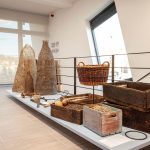FISHERMEN’S MUSEUM
VRBOSKA
Since its earliest development, Vrboska has been economically oriented towards the sea, and the identity of the local population was essentially influenced by fishing traditions. The development of the settlement in the 15th century was directly connected with sardine fishing. The development will later be continued by combined fishing and agricultural practices. Preserving the memory of the importance of fishing history of Vrboska provided a strong incentive to the former Center for the Protection of Cultural Heritage of Hvar to form the Fishermen’s Museum in Vrboska in 1972. Today, the museum’s collection forms an integral part of the Municipal museum of Jelsa. From its founding until 2021, the collection was displayed on the ground floor of the Dežulović family house on the waterfront in Vrboska. In the summer of 2025, the museum moved into a new building purpose-built for the presentation of the Fishing Collection on the northern shore of the Vrboska bay.
Most of the exhibited objects were owned by fishermen’s families from Vrboska and other island settlements. They are specific to the second half of the19th and first half of the 20th century, a period in which fishing and shipping were important economic activities in Dalmatia. The collection holds numerous objects which illustrate traditional fishing techniques and fishermen’s lifestyle, specific not only to the island of Hvar but the Adriatic as a whole, since similar or identical tools were used on other islands and along the coastline. One part of the collection is dedicated to fishing for small pelagic species, a dominant form of fishing in the history of Dalmatia. A specific form of fishing “under the light” (“pod sviću”) was traditionally performed by burning pine wood on iron grid (“svićalo”) mounted on the boat’s bow. The Collection also includes other types of fishing lights used in later periods, as well as many other tools used for catching and processing fish. Some of these objects include tridents, fishing hooks, longlines, various types of fishing nets used for different purposes, tools for mending nets and sails, wooden barrels (“barili”) for salt preservation, and tools necessary to make such barrels. The Collection also holds objects that belonged to the inventory of the former sardine factory in Vrboska, which was founded in 1898 by Societe General Française, a company from Trieste, as well as utensils used in traditional fisherman’s cuisine, characterised by an economical, rational and seasonal approach to food, form another important part of the Collection. The permanent exhibition of the Fishermen’s museum in Vrboska provides a coherent image of the fishermen’s life with intertwined material and non-material elements of ethnographic heritage, both of which are still very present in the identity of Vrboska.









